Years ago I built a chicken tractor, which at the time was the newest and coolest trend in homesteading. What it was, in essence, was a moveable coop with no bottom: you pulled it around the yard and the chickens ate up all your bugs and aerated the lawn/garden and made life awesome by pooping on everything. Except that the “tractor” (an enclosed house attached to an 8’x8′ “yard”) was too heavy to move through tall grass or damp soil, and eventually it just became a base from which the chickens foraged in the yard every day*. So it didn’t really tractor all that much, nor did it really matter in the end. I finally burned the coop last year, 10 years after moving the girls into a permanent home in a dirt-floored area of my barn.
So I told you that story to tell you this one: I’m a little skeptical when it comes to miracle chicken strategies. But I came across one of those ideas that makes so much sense you suddenly wonder why you’ve been doing things the hard way for years.
For example, following the retirement/abandonment of the tractor, I used to clean out the aforementioned barn every few months, put all the manure and straw on my compost pile, and place brand new straw on the now-tidy dirt floor. Why? Because you have to clean the chicken coop.
But what if you didn’t clean the chicken coop? Well then all that crap would pile up and that would be a bad thing, right? Quite the contrary. Handled properly, it’s a really good thing.
Let me explain.
Chickens are tireless diggers, as anyone who has let a dozen loose in the yard can tell you. They also generate tons of nitrogen, converting everything you feed them into easily-rotted pellets. Let’s see: we have nitrogen, and we have mixing. All we need now to make some really awesome garden compost is carbon, moisture, and time.
A few years ago, I followed some advice from an American gardener living in Central America: instead of letting the chickens out to dig the compost pile, bring the pile in to them. Instead of cleaning the coop, add carbon and nitrogen to it every day, then only remove finished compost the chickens create.
By adding leaves, grass clippings, shredded paper, and/or food scraps to the coop every day, one will quickly build up a 2-foot-deep, 3-layer floor.
Layer 1, the top: all the stuff you throw in. The leaves still look like leaves and the pumpkins still look like pumpkins, and maybe the chickens eat it and maybe they don’t. Make sure it’s damp (I just dump the chicken’s water dish on it every day).
Layer 2: the layer everyone loves. This is half-rotted stuff that worms have come up from below to devour and that chickens dig into to get the worms. Chickens dig all day long, mixing layers one and two, getting protein from layer two, and leaving nitrogen on layer one. That nitrogen, mixed with the carbon you add, is constantly creating the stuff that settles to…
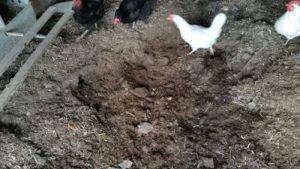
Layer 3: finished compost. Once the worms and chickens are done, the bottom layer is garden-ready. All you have to do is dig it out about every 8 weeks, depending upon how much stuff you add. Add enough stuff and you’ll never lack compost again.
The obvious questions I worked through when I started this experiment:
- Is it safe for the chickens?
The idea of chickens stomping around in two feet of their own crap is disconcerting at first. On the other hand, it’s not really any different than the floor looks between bi-monthly cleanings. Chickens crap a lot. They crap in their water, they crap in their nesting boxes… and it really doesn’t seem to bother them much. In the chicken composter, there’s actually less crap lying around, since they are constantly mixing it in with two feet of other material.
- Is it worth the work?
All in all, it’s really not that much work. I go to the cage every day anyway – bringing a bucket of shredded paper or carrying a bag of leaves isn’t that much extra. That stuff had to go to the compost pile anyway. Cleaning day may seem like a lot of work, but you’re just working in the coop rather than in the compost pile at that point. If it’s more work, it’s because you’re getting more compost.
- It is nice to talk about differing layers of stuff, but how does one remove the bottom layer while leaving the top intact?
I’ve found that on cleanout day, it’s easiest to just scrape the top layer from about a 5’x5’ section and shovel the lower stuff into buckets. No matter what you disturb or how you disturb it, the chickens will have everything moved back by the next day anyway. I do let them out while I’m scooping, however.
- Are there any downsides?
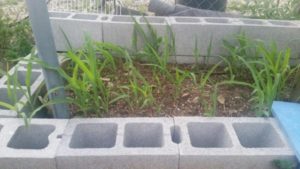
The only one I’ve come across so far is that seeds tend to survive the process. If you use grass clippings, your compost will likely sprout grass. If your chickens ignore deer corn, some will come up in your beds after composting. I tend to be heavy on shredded paper and leaves, so I don’t get too much trouble from seeds. And what I do get is reduced by a good shredded paper mulch, liberally applied. I also stopped giving them deer corn.
One final caveat. After the first time I cleaned it out, I got excited about building the pile quickly again. So I grabbed about six trash cans full of leaves from beneath the Lovely and Gracious Rogue’s oak wall out front; the kind of leaves that crunch and crumple and that kids love to destroy big piles of. And I dumped them all in and spread them about, while the ladies clucked and fussed and hid in the nesting boxes. Then I headed up to the house for about 15 gallons of shredded paper I was going to add to the mix.
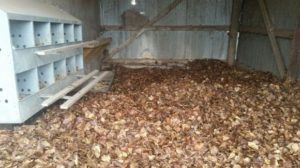
When I came back, there were no chickens in sight. And there is that moment of panic where you wonder if you left the door open and they all ran out and got eaten by coyotes, or you wonder if you accidentally buried them all alive. You know the feeling. It turns out that they were all roosted in the rafters. I’m not sure if I freaked them out while adding the leaves, or if the leaves are too loud, or if by covering up all the crap and pin feathers they are used to walking on I made them feel not-at-home. But for the rest of Saturday they were content to sit 12′ above their beautiful new floor, clucking quietly.
They came down eventually. All those yummy kitchen scraps I tossed on top weren’t going to eat themselves. But all those leaves took longer to mix than if I’d been patient and given them a bag a week or so. As with all gardening strategies, your results may vary.
* True story about how stupid chickens truly are. The ‘tractor’ had been sitting in one place in the yard for about 10 days, with the chickens going out and in at their leisure, except at night when they were locked up. On day 11, I moved it about 30′ away because I wanted them closer to the fence line. After dark on night 11, I went out to check on them. Every single one of them was sitting on the ground in the bare dirt where the coop had been. Though the coop was in plain sight 10 yards away, not one of them managed to go into it.

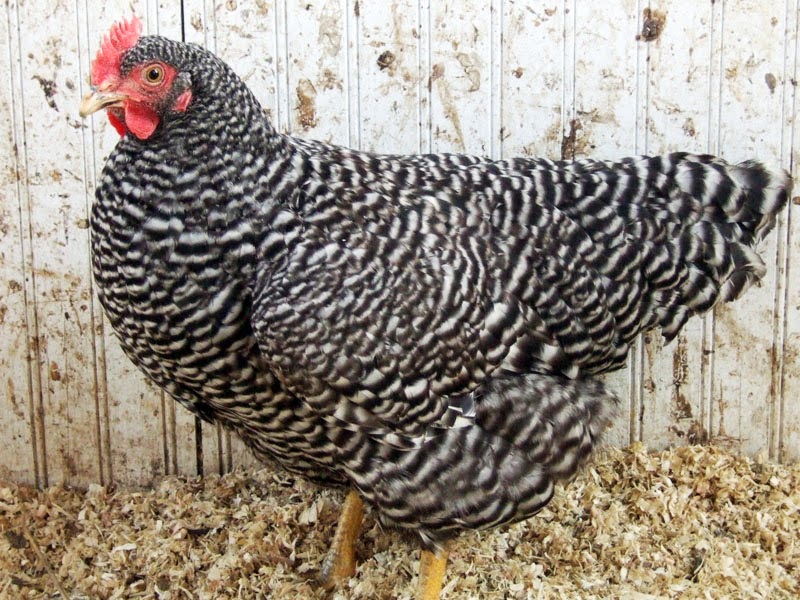



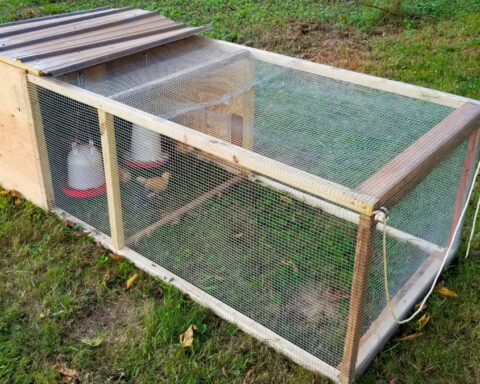
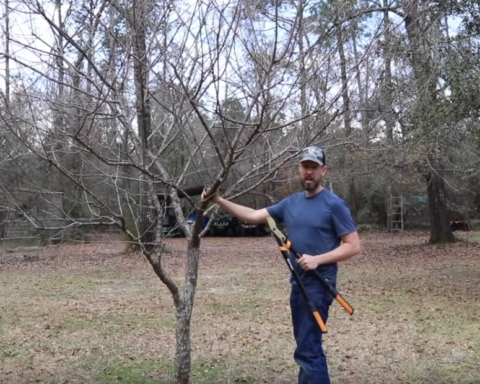
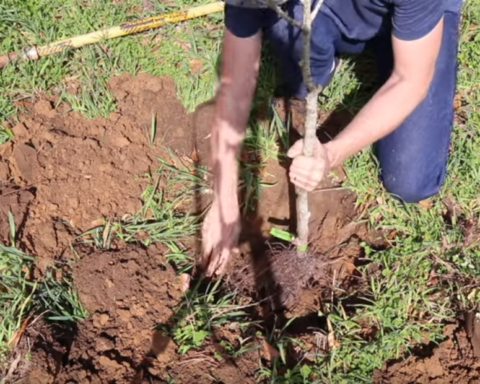
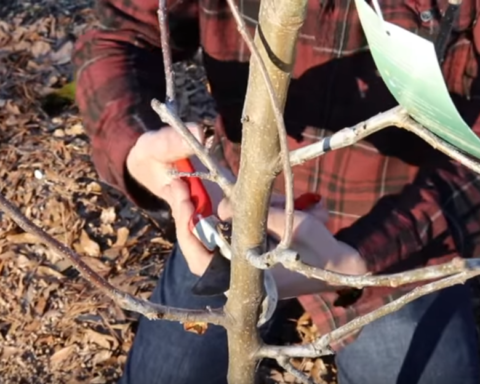

Excellent Article! I use this method and it works well. I made the mistake of building their coop on stilts; this is a PITA to clean.
4.5
5